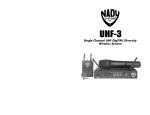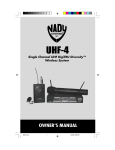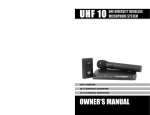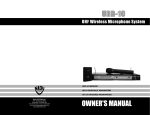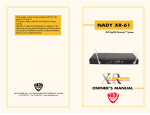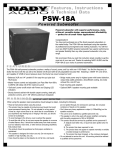Download Nady Systems Microphone U-33B User's Manual
Transcript
U-33B UHF Bass Wireless Microphone System DigiTRU Diversity™ Nady Wireless Systems are type accepted under FCC rules parts 90, 74 and 15. The device complies with RSS-210 of Industry & Science Canada. Operation is subject to the following two conditions: (1) this device may not cause harmful interference and (2) this device must accept any interference received, including interference that may cause undesired operation. NADY SYSTEMS, INC. 6701 Shellmound Street • Emeryville, CA 94608 USA Tel: 510/652-2411 • Fax: 510/652-5075 www.nady.com OWNER'S MANUAL SERVICE (U.S.) Should your Nady Wireless Microphone System require service, please contact the Nady Service Department via telephone at (510) 652-2411 or e-mail to [email protected] for a Return Authorization (R/A) Number and a service quote (if out of warranty). Make sure the R/A Number is clearly marked on the outside of the package and enclose a cashier's check or money order (if not prepaid with a credit card). Ship the unit prepaid to: Nady Systems, Inc., Service Department, 6701 Shellmound Street, Emeryville, CA 94608. Include a brief description of the problems you are experiencing. The warranty card enclosed with this system contains additional valuable warranty and service information. Keep it in a safe place for future possible reference. Do not attempt to service this unit yourself as it will void the warranty. (International) For service, please contact the Nady distributor in your country through the dealer from whom you purchased this product. 11 SPECIFICATIONS U-33B OVERALL SYSTEM PERFORMANCE Frequency Response Dynamic Range Total Harmonic Distortion RF Carrier Frequency Range Frequency Stability Modulation Operating Range 30 Hz - 18 KHz, – 3 dB 120 dB < 0.6% UHF, choice of single frequencies from 470-500 MHz ±0.005%, crystal controlled FM (F3E), ±10KHz normal, ±40KHz max Up to 250 ft. typical (depending on site conditions); up to 500+ feet optimum line-of-sight Bass Booster Control LED Indicators Unwanted Signal Rejection Power Requirements Dimensions (Max.) Weight Antenna DigiTRU Diversity™ (Dual Antenna) External Control Power ON/OFF, Volume Control, Squelch (Mute) Adjust DC in, 1/4”(6.3 mm) unbalanced phone jack (225 mV/ no load), XLR balanced output (±20 mV/600 Ohm load) +8dB @ 100Hz Power ON, Diversity A/B, Audio Level and Peak 60dB image and spurious DC 18V @ 250mA, AC/DC adapter included 1.75" x 7.5" x 8.1" (4.4 x 19 x 20.7 cm) 1.6 lbs (.73 kg) 11.2" (28.5 cm), dual folding antennas UB-33B BASS TRANSMITTER Audio Inputs Controls LED Indicator RF Power Out Harmonic & Spurious Emissions Battery Battery Life Dimensions Weight CONTENTS ....................................................................................................... 3 INTRODUCTION ................................................................................................ 3 USING THIS MANUAL ....................................................................................... 3 FEATURES ......................................................................................................... 4 U-33B RECEIVER ................................................................................................ 5 UB-33B BASS WIRELESS TRANSMITTER ............................................................... 8 U-33B BASS RECEIVER Reception Mode Squelch Controls Connectors CONTENTS 3.5mm instrument locking mini-jack POWER, AUDIO ON/OFF Bi-color, Unit “ON” (green), Low Battery Alert (orange) 50mW nominal (maximum allowed by FCC) < –50 dB AAA Alkaline (2x) 4-5 Hours 3.25” x 2.187”x 1” (8.25 cm x 5.53 cm x 2.54 cm) 2.25 oz (0.064 kg) without battery SPECIFICATIONS ............................................................................................. 10 SERVICE .......................................................................................................... 11 INTRODUCTION Thank you for purchasing a Nady U-33B Bass Wireless Microphone System and congratulations on your choice. The U-33B is loaded with top professional operating features and is the best performance and price value available in UHF diversity bass wireless systems. USING THIS MANUAL This booklet gives instructions for the operation of the U-33B UHF wireless system. Please read the instructions for your system completely before operating unit. This manual will first list the features of the U-33B and then will take you step by step to show you how to operate your new system. Included in this manual are system specifications and servicing information. 10 3 SYSTEM FEATURES U-33B BASS RECEIVER • Specially customized for use with bass guitar transmitter and features Enhanced Headroom™ for maximized possible clarity and distortion-free audio • Unique user adjustable Bass Boost™ control for dialing in the exact desired bass punch and presence missing in standard wireless • Nady’s proprietary companding circuitry for an industry best 120dB Dynamic Range, and clearest, most natural sound available • Clear channel operation on the wide open, unclustered UHF band for interferencefree performance in any application or locale • DigiTRU Diversity™ for optimum range and dropout protection • A-B antenna LED indicators • 5-LED AF display for monitoring audio level • Unbalanced 1/4" and balanced XLR outputs (for bass amp or direct mixer feeds, or both). Volume control for unbalanced line output. Fixed level for XLR output • External Mute (squelch) adjust control • Half-rack receiver design with folding front panel dual one section telescopic antennas • Unique snap-out panel locking tabs for half-rack single receiver or full rack (sideby side) dual receivers mounting with option accessory • Externally powered by AC/DC power adaptor 22 18 19 20 21 23 UB-33B BASS TRANSMITTER • Compact small sized • Removable rubber ducky antenna • Customized specially for use with U-33B bass guitar receiver. Features enhanced Headroom™ for maximum possible clarity and distortion-free audio, even with high output active pickups • Audio mute switch allows convenient audio muting with the transmitter “ON” • Bi-color LED status indicatior: “ON” (green), Low Battery Alert (Orange) • Locking 3.5mm mini-jack provides secure connection for removable instrument cable • Convenient, economical operation with two AAA Alkaline or NiMH batteries 17 16 24 4 9 UB-33B BASS WIRELESS TRANSMITTER U-33B RECEIVER 1. Open the hinged BATTERY DOOR (16) and insert 2 fresh AAA ALKALINE BATTERIES into the BATTERY COMPARTMENT (17), observing the correct polarity. Fresh alkaline batteries can last up to 5 hours in use, but in order to ensure optimum performance, it is recommended that the batteries be replaced after 3-4 hours of use. 1. Rackmounting the Receiver There are 2 options available for rackmounting the U-33B receiver: singly or side-byside with another U-33B receiver. a. Single mounting: Remove the receiver SIDE MOUNT CLIP (1) from each side of the receiver (as shown) and slide in the optional ERM-3 RACK EARS (2). b. Side-by-side double mounting: After removing the SIDE MOUNT CLIPS (1) from both U-33B receivers, join the two receivers with the EJC-3 JOINING CLIP (3) and attach the ERM-33 RACK EARS (4) as shown. (Note: Do not mount the receiver in a rack directly above an amplifier or other source of high heat – this could degrade the performance of the U-33B. Always ensure adequate airflow and heat dissipation in any rack configuration.) 2. The UB-33B is provided with a 3.5 mm LOCKING JACK (18) for connecting the audio input selected. Connect either the INSTRUMENT CORD (24), to secure the connection, turn the slip ring on the plug clock wise to thread it on the jack. To unplug, reverse the process. Slip the transmitter into a pocket or CLIP (23) it onto your clothes or instrument strap. 3. Turn on the UB-33B by sliding the audio AUDIO SWITCH (19) to the OFF position first then slide the POWER SWITCH (21) to the ON position. The Bi-Color LED indicator (20) will stay on (GREEN), indicating usable battery strength and that the transmitter is on. In the case of dead or low batteries, the LED will either not go on at all or will stay on (ORANGE) continuously, indicating that the batteries should be replaced with fresh ones. To preserve battery life, turn the transmitter off when not in use. The A or B Diversity LED indicators (13) on the U-33 receiver should now be lit, indicating a received signal from the transmitter. 4. Instrument Use Secure the connection from the GT CABLE (24) by turning the slip ring on the plug into the transmitter clockwise to thread it on the jack. To unplug, reverse the process. Plug the 1/4” phone plug into the instrument. When ready to play, slide the AUDIO SWITCH (19) to “ON” position. Adjust the volume of the receiver as per the Audio Output Instrument Connection section of the above U-33B receiver instruction. (Note: The UB-33B is supplied with a removable antenna. It should be operated with the supplied antenna all times. For optimum operating range, always maintain lineof-sight between the transmitter and the receiver whenever possible.) 8 2. Powering the Receiver Plug the 18V AC/DC ADAPTER (5) provided into the DC INPUT JACK (9) on the back of the receiver. Then plug the power supply into an AC outlet. (Note: Any 18V DC source with 250mA capability can also be used.) Press the POWER SWITCH (11) once to turn on the receiver. The POWER ON LED (12) will now light and the receiver is operational. 3. Antennas The U-33B receiver is supplied with FOLDING ANTENNAS (15). These should be extended fully to obtain maximum range. Optimal antenna position is 45 degrees from the receiver (at 90 degrees from each other). For maximum range, it is always best to maintain a line of sight (no obstructions) between the receiver antennas and the transmitter at all times whenever possible. 4. Mute (Squelch) Adjustment In normal operation, the SQUELCH CONTROL (6) should be set fully clockwise to the factory preset RF level (Max. Sens.). However, in areas of high RF activity, the squelch (or mute, as it is sometimes called) may need to be adjusted to compensate for the adverse conditions in a particular location. If, with the transmitter off, the receiver’s A or B DIVERSITY LED INDICATORS (13) flicker or stay on, the squelch control should be turned counterclockwise until the A or B LEDs extinguish. When the squelch is properly adjusted, the A or B LEDs will only light when the system transmitter is turned on. Turning the squelch control too far counterclockwise will reduce the range, but yield a quieter squelch (mute) function. During operation, especially at ranges greater than 75 feet, one or the other of the A or B LEDs may extinguish briefly. This is normal—the unit’s DigiTRU Diversity™ reception ensures that the received audio will not be interrupted. When both LEDs extinguish, the transmitter is out of range for that given location, and the user should move closer to the receiver to re-establish the radio link. 5 5. Bass Boost Control Ordinary wireless systems all sound somewhat thinner (with less bass) than hardwired. This is due to (1) natural side effects of the noise reduction circuitry employed, and (2) lack of the high-frequency roll-off normally caused by longer hardwired cable runs. Adjust the BASS BOOST (15) control to add back low frequency content in your signal as desired. This is a low-pass filter, with up to 6 dB of gain, over flat respsonse centered in the 30-300Hz, when turned fully clockwise. The normal wireless sound is with the control left fully counterclockwise. 15 6. Connecting the Audio Output The U-33B receiver provides both a fixed mic level BALANCED AUDIO OUTPUT XLR (7) and an adjustable line level UNBALANCED AUDIO OUTPUT 1/4" JACK (10). The level from the UNBALANCED OUTPUT is controlled by the rear panel VOLUME CONTROL (8). 15 12 11 14 13 Insert an audio cord with a 1/4" mono phone plug in the UNBALANCED OUTPUT JACK (10) on the rear panel of the receiver. Plug the other end of the cord into an amplifier, effects, or mixing board. Adjust the VOLUME CONTROL (8) on the U-33B receiver clockwise to maximum rotation, until the volume level is comfortable for your application. This setting is roughly equivalent to a direct instrument cord connection. (Note: You can connect both outputs at the same time for added versatility in use. For example, simultaneously hook up the UNBALANCED AUDIO OUTPUT (10) to your bass amplifier and the BALANCED AUDIO OUPUT (7) to the FOH mixer.) VOLUME BASS BOOST MUTE UNBALANCED OUT DC INPUT BALANCED OUT 15 (Note: As when making any connection, make sure the amplifier or mixing board volume is at the minimum level before plugging in the receiver to avoid possible sound system damage. Also make sure that the phantom power on the input of the mixer is turned OFF before making connection to the receiver.) 10 9 8 7 5 6 1 2 2 1 4 3 4 6 7








